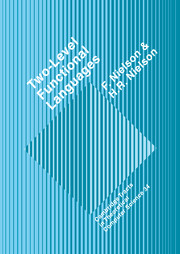6 - Code Generation
Published online by Cambridge University Press: 12 October 2009
Summary
The previous chapter developed the notion of parameterized semantics for the mixed λ-calculus and combinatory logic. This was applied to showing that the run-time part of the language could be equipped with various mixtures of lazy and eager features. In this chapter we shall stick to one of these: the lazy semantics S. The power of parameterized semantics will then be used to specify code that describes how to compute the results specified by the lazy semantics.
The abstract machine and the code generation are both developed in Section 6.1 as it is hard to understand the details of the instructions in the abstract machine without some knowledge of how they are used for code generation and vice versa. The abstract machine is a variant of the categorical abstract machine and its semantics is formulated as a transition system on configurations consisting of a code component and a stack of values. The code generation is specified as an interpretation K in the sense of Chapter 5.
The remainder of the chapter is devoted to demonstrating the correctness of the code generation, K, with respect to the lazy semantics, S. To cut down on the overall length of the proof we shall exclude lists from our consideration. Section 6.2 then begins by showing that the code generation function behaves in a way that admits substitution. Next, Section 6.3 shows that the code generated is ‘well-behaved’ in that it operates in a stack-like manner.
- Type
- Chapter
- Information
- Two-Level Functional Languages , pp. 139 - 206Publisher: Cambridge University PressPrint publication year: 1992

